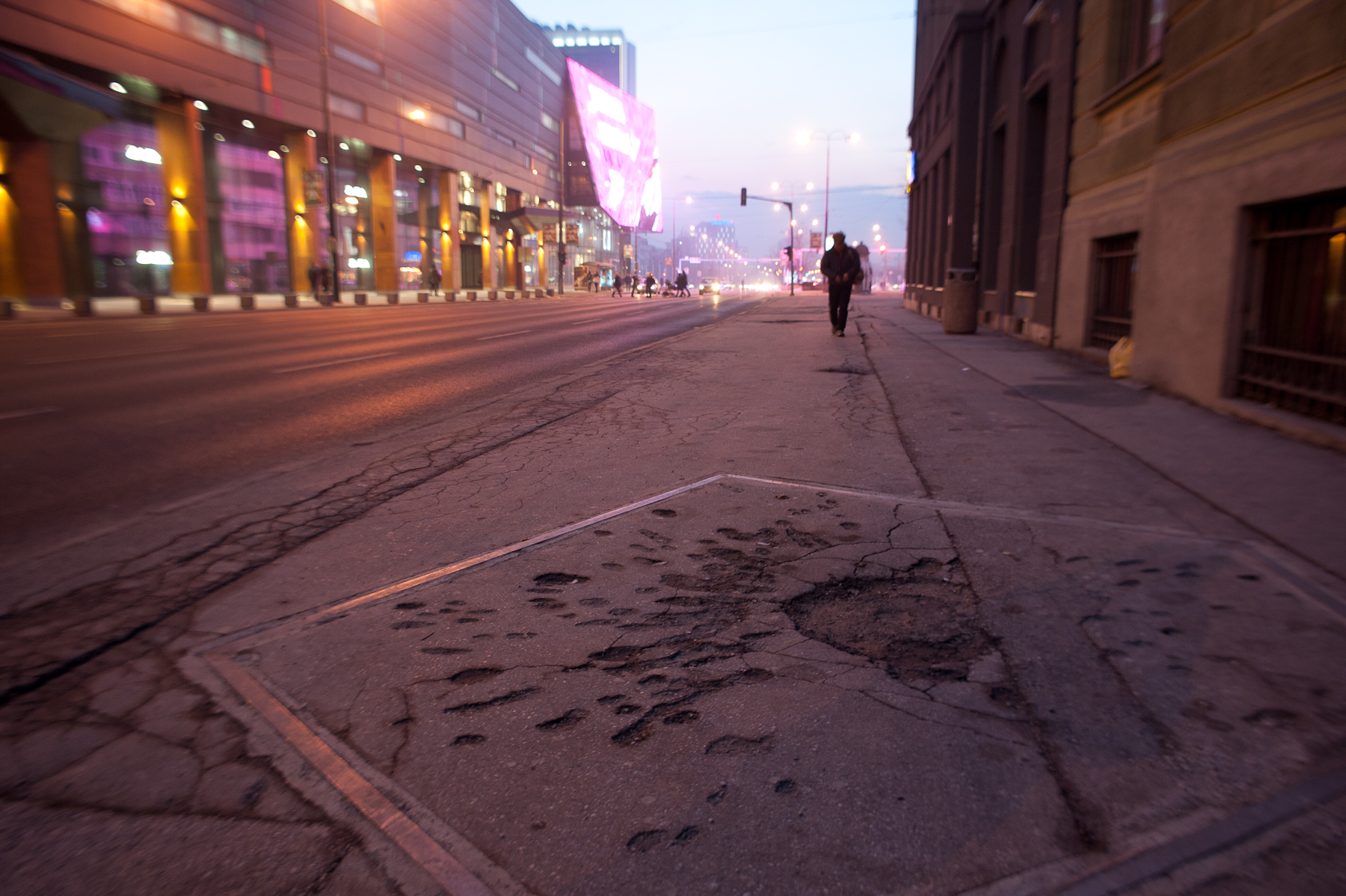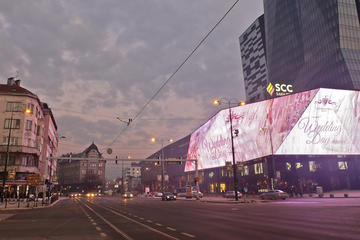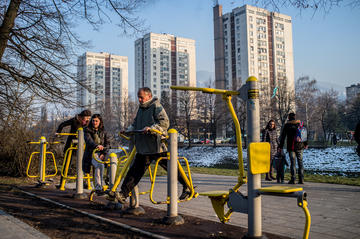
Sarajevo, February 2015 (Photo Fabio DiEvangelista)
Sarajevo is not the city it once was. There are no longer tens of thousands of inhabitants – some have betrayed it, others have left it. But it can't be blamed for this. Slowly it's coming back to life, as if after an earthquake
“Sarajevo is muslim.” This can be a statement or a question, a reproach or an accusation. Whichever it is, over the last twenty years this statement has often been repeated, and every time causes an argument.
It's true that today the majority of the people living in Sarajevo consists of Bosnian Muslims. The exact figures will not be known until the publication of the 2013 census, the first and only one since the war. Then it will be clear how things stand.
A town where Muslims predominate is not bad in itself, nothing to be ashamed of or to apologise for. Sarajevo is the largest town in Bosnia Herzegovina and here the atmosphere and spirit of Islam are felt more strongly than elsewhere, but this does not mean the town is muslim.
The phrase “Sarajevo is muslim” rings out a high-sounding note. In fact, who says it accuses the town of being clerical, non-secular, non-democratic and non-European.
All this is not true.
Changes
The population of Sarajevo has changed greatly in the last twenty years, particularly during the war. But not just because the number of non-Muslims has decreased. At least a third of the total number of inhabitants living there before the war, is there no longer. The number of Serbs, Croats, Jews and Roma has diminished – but also tens of thousands of Sarajevan Muslims have gone elsewhere. Of the five households of my close relatives, today in Sarajevo there is only one.
Before the war Serbs made up a third of the city population (157,143 or 29.81%). Today they are estimated to number about forty thousand. Twenty years ago 34,873 Croats ( 6.61% ) lived in Sarajevo: now they number about 16,500. Those who felt to be and said they were Yugoslavs were 56,470 (10.71%) of the population. Today it takes courage to declare oneself Yugoslav – not only in BiH, but in all of exYugoslavia – because this would risk classification as Yugonostalgic, a label close to treason.
Recently Nenad Janković, stage-name “Dr. Nele Karajlić”, has repeated: “ I'm not going back to Sarajevo until the two hundred thousand exiled Serbs return.” Nenad Janković was one of the chief characters in the legendary TV show “Top lista Nadrealista”. Now he's with the rock group (the new one in Belgrade) “No Smoking Orchestra”. He took off from Sarajevo for Belgrade two or three days before the war began. From Belgrade he disparaged his native town, saying Sarajevo had never been a multi-ethnic and multi-religious city, and that the friendships, tolerance and living together was all a fabrication.
Those who, like Nenad Janković, criticize the absence of non-Muslims in Sarajevo, in fact hold Sarajevans responsible for ethnic and religious cleansing. Whereas Sarajevo today is (also) muslim,
not because Sarajevan Bosnians practiced ethnic cleansing or because its citizens of Islamic religion destroyed their long-standing multicultural and multireligious tradition. The “cleansing”, according to the facts and testimonies, was done in a different way.
1992: the get-away
The first Serbs to leave Sarajevo some days before the war began, in April 1992, were those who knew, because they had received secret information, that the city was about to be attacked. The Bosnian Serbs' Party, SDS, had spread the news that the battle for Sarajevo was to begin, just among its members and Party faithfuls, suggesting they “take refuge for about ten days”. Time enough, they believed, to take Sarajevo, then they could return when things had calmed down. I think many non-Serbs would have done likewise, had they had this information. When we understood what was happening, however, it was too late – Sarajevo was already under siege and to leave was both difficult and dangerous.
The initial flight of the Serbs was a bitter shock for the non-Serbs. Our friends, colleagues, neighbours and acquaintances till yesterday, had information of the imminent danger and did not want to share it with us. We felt betrayed.
Some disappeared, leaving suddenly, saying nothing, simply seen no more; others took ten days' leave “to deal with jobs needing urgent attention”, they said; others hurried off to visit their family in Serbia or Montenegro; still others went to their weekend house in a safe part of the country, that was controlled by Serbian nationalists. Some took sick leave. A neighbouring couple went off, with suitcases, “to pick mushrooms” they told us. Our friend Nada took her family to Pale, the stronghold of the Serbian nationalists. She phoned us from up there, all through April 1992 asking how things were down in town, and told us to be careful because the bombardment was about to begin.
In this first phase women and children left for safe havens, while the men remained in town to look after their flat and their job, convinced that within a week the Serbs would enter Sarajevo triumphantly. One witness to these movements is to be found in an article by the Serbian journalist Risto Dogo, known for his “turbo” nationalism. On April 5th 1992, the day before the war began, Dogo wrote a report testifying to the Serbian exodus from Sarajevo. But that day only those who knew the Serbs were about to attack left the city. Risto Dogo's article confirms this: “... Thousands of Serbian children, women and elderly are leaving. They are directed towards the Serbian territory of Pale. . . At the junction at Vraca I met Ljubo Nikolić, a colleague . . . I took his wife and children to transfer them to Romanija. Whereas Ljubo went back to the muslim part of Sarajevo.”
There were some celebrity escapes – the star journalist on Sarajevo TV, Dubravka, who, using the excuse of feeling threatened, went off to Belgrade, paid by the TV channel, for a month, never returning. Another colleague, the Brussels correspondent of the daily “Oslobodjenje”, came back, not to his native city, but to Belgrade, to be “with his people”, the rest of his family being already there, in safety.
While the Serbs left Sarajevo, Muslims and Croats arrived, evicted from the areas attacked or occupied by Serbs. In the first months of 1992, thousands of Muslims arrived from eastern Bosnia where the Serbs had effected deep ethnic cleansing; then from April even from the parts of Sarajevo occupied by the Serbs – Pale, Vogošća, Grbavica, Ilidža, Sokolac, Nedzarići, Dobrinja, Lukavica, Rajlovac, Nahorevo.
My sister, a doctor in Pale, was told, on April 5th 1992, “not to come back there”. Similarly, many other non-Serbs were made to leave Pale. Mladen Vuksanović, a journalist with Sarajevo TV, writes about this in his book “Dnevnik s Pala” (Pale Diary). His father was Serb, his mother Croat and this enabled him, not being Muslim, to stay for the first three months of the war in Pale without the risk of expulsion. He then escaped to Istria, where he died in 1999.
“They make a list of the Muslims who have to leave their houses, farms, livestock and goods, to go to Sarajevo... The Muslims, with whom I've shared my whole life, the good and the bad, stand there waiting for the bus, crying like children. Because they have to leave their house, land, cows and sheep and, with a bundle in their hand, descend into the inferno of life as a refugee.”
In May 1992, a month after the beginning (official) of the war, there were already seventeen thousand Muslim and Croatian refugees in the centre of Sarajevo, evicted from the surrounding areas occupied by the Serbs. On one day alone, July 22 1992, when the High Commissioner for Refugees, Sadako Ogata, was visiting the region, three thousand Muslims arrived in the city, evicted from Pale.
In June 1992 the “Maršal Tito” barracks in the centre of Sarajevo, the biggest in BiH, were evacuated. On that occasion, counting the soldiers, officers and their families, several thousand non-Muslims left the city. A colleague of mine, who was among them, told me her non-Serb neighbours tried to stop her leaving, knowing that once the Serbs had left the city the destruction of Sarajevo would be faster and more violent.
The Siege
Once Sarajevo was under siege, to leave the city became very difficult. Desperate, people invented ways and means of escaping – along the drains, crossing the river, going through minefields or via the airport. In Belgrade I met a Serb who told me he escaped while digging trenches for the Bosnian army at Dobrinja. Another Serb got away because he was part of a humanitarian organization, “Dobrotvor”. Others paid UN peacekeepers who, for a few thousand German marks, would get them to safety.
There was also an official channel for leaving the besieged town - the exchange of people who wanted to be with “their own”: in exchange for Muslims coming from Serb held territories the same number of Serbs were allowed out of the town. In these escapes from the siege, however, the non-Muslims had an advantage in that once out, the Serbs and Croats found places controlled by their own people, while Muslims fleeing Sarajevo risked ending up in enemy territory. In fact many Muslims, saving themselves from the siege, finished in concentration camps or prison or were killed. A tragic case was the one in which some Bosnian Muslims who escaped to Montenegro were captured by the local police, handed over to Bosnian Serbs and never seen again. A friend of mine, who managed to escape from Sarajevo, hid with friends in Rovigno, in Croatia, before going on to Italy. In Croatia she could never go out in the street because the Croatian police were rounding up Bosnian refugees.
However some anomalous cases of exit from Sarajevo come to mind: for example, Nenad Kecmanović, a University lecturer who, at the start of the war, was part of the Sarajevan government. He left town in order to negotiate with the Bosnian Serbs, stayed in Pale, then transferred to Belgrade where his family were already safely placed. Or the flight of the famous, like the fore-mentioned Nenad Janković, or Goran Bregović and Emir Kusturica who, during the war settled in Belgrade. Their choice was a political statement since they stayed with the Serbian regime which besieged Sarajevo and bombarded it for four years.
During the war the Serbs who stayed in Sarajevo, scornfully called by the ex-leader of the Bosnian Serbs, Radovan Karadžić, “the Serbs of Alija” (Izetbegović, former Bosnain president), largely shared the fate of their fellow citizens: the hunger, cold, sniper fire and bombardments. It's estimated that of the twelve thousand Sarajevans killed in the war, at least a quarter were members of the Serbian population or of Serbian ethnic origin.
Kazani
In all and everything the Serbs of Sarajevo shared the fate of their Muslim and Croatian neighbours, except in the so-called “Kazani” case, in which Sarajevans of the Orthodox church were the principal victims. In a ravine in the slopes of Mount Trebević, innocent Serb and Croat civilians were shot, in 1992 and 1993, captured and killed by the Commander of X Brigade of the Bosnia Herzegovina army, Mušan Topalović, “Caco”. The case of Kazani had been reported in the Sarajevan weekly “Dani” in 1993. Caco was killed in battle in 1993 and, after the war, buried as a hero.
To date, the remains of twenty nine people have been recovered from the Kazani ravine, even if the official number of victims has never been determined. For the crimes of Kazani, fourteen soldiers of the Bosnia Herzegovina army have been sentenced, although, according to experts, the punishments do not correspond to the gravity of the crime. The Bosnian authorities have never made a systematic analysis of the identities and number of victims who disappeared in the pits of Kazani, which leaves an opening for speculation about a political use of the victims, and stains the legitimate and heroic defence of the city.
1996: the Exodus
The biggest exodus of Serbs from Sarajevo took place in the first months of 1996 when the parts of the city occupied during the war by the Serbian army (Grbavica, Vogošća, Ilijaš, Hadžići and others) had to “reintegrate” with the town, as prescribed in the Dayton Peace Agreements.
The chief Bosnian Serbs, in particular Momčilo Krajišnik (comdemned in the Court of the Hague for war crimes) had encouraged the Serbs to leave Sarajevo so as not to remain “in the country of Alija” (Izetbegović). And they told them not only to take all they could with them, but even to exhume and carry away their dead. Their political and military emissaries went round checking who left, convincing Serbs who were hesitant or undecided with threats or force. I knew some people in the quarter of Grbavica, the couple Vera and Duško, and Živko and Milica, who decided to stay in their own homes. Right to the last day, to defend themselves, they told those who were pushing them to leave: “We're ready to go, just waiting for the truck for Serbia.”
In those three months preceding the reunification of Sarajevo, all that the Serbs were unable to take with them was destroyed and burnt. For days thick clouds of smoke from the fires darkened the sky. The damage amounted to tens of billions of dollars, caused by relocation or burning of factories and industrial plant; all the public offices, health services, schools and residential buildings were completely devastated. Everything, down to the last gutter and window was taken away or destroyed.
Jovo Janjić, a Serb in Ilidža, did not leave his house. “They put pressure on us to leave, promising lots of things elsewhere – the building of a bigger and more beautiful Sarajevo, better than this one. They showed us a model of the new city of the future; they promised the earth.”
The Serbs moved in their thousands, many in tears. The exodus was neither spontaneous nor chaotic. Most of them settled in the Sarajevo district under the administration of the Republika Srpska (RS), that is at Lukavica and Pale. Entire quarters of Serbs, like Hadžići, for example, were transferred to two towns in eastern Bosnia – Bratunac and Srebrenica – which had been cleared of Muslims. Thus many towns were ethnically homogenized, after, with the Dayton Accords, they had been consigned to the Republika Srpska. These included Višegrad, Foča, Banja Luka, Bijeljina, Zvornik, Vlasenica, Trebinje, Doboj, Tešanj, Bosansko Grahovo, Prijedor and Bosanski Brod.
After the Earthquake
With the peace, the haemorrhage of Sarajevans from their city did not cease, and not just of the Serbs. It was a similar process to stabilizing after an earthquake, with many little tremors. Many, who had spent the whole war there, left. Those who could stand it no longer, embittered, disappointed, tired, fearful, looked for a better, safer future elsewhere – Canada, America and Australia were the preferred destinations, but also nearby Serbia and Croatia. Some moved to other parts of Bosnia Herzegovina, where their own people were in the majority.
In parallel, Muslims from parts of BiH came to Sarajevo for security – the city which had undergone the longest siege in modern history seemed safer to those fleeing places being ethnically cleansed of non-Serbs, like Srebrenica, Cerska, Višegrad, Foča, Bjeljina, Bileća and Stolac. “The worst never ends” is a Bosnian saying.
Over the last twenty years, after the end of the war, the Bosnian Serb politicians have never stopped demonizing Sarajevo, to make it look unattractive to non-Muslims. They reproach it for having more mosques than Teheran, to insinuate a sense of religious extremism. Last year's social protests were interpreted by the Bosnian Serb heads as “anti Serb”. When Serbs living in Lukavica or Dobrinja (in the RS) go shopping in the city centre, they are chided for their lack of patriotism, and, if they stop to talk to an acquaintance or colleague there, they have to be careful not to be seen “socializing” with Muslims.
The sick in these parts of the RS are not cured in the nearest hospital in central Sarajevo, but at Banja Luka, two hundred kilometres away. If a student from Banja Luka decides to study at Sarajevo, it creates a sensation and when Sarajevans tried to help Serbs at flooded Doboj, their help was refused. Who accepted was labelled a traitor and in the case of public sector workers, dismissed.
Sarajevo is not what it once was. It no longer has tens of thousands of its inhabitants, some betrayed it, others left. But some people remained. Jasmila Zbanić, Danis Tanović, Ahmed Imamović, Srđan Vuletić, Jim Marshal, Emir Hadžihafizbegović, Dino Mustafić, Faruk Šehić, Ozren Kebo, Nenad Veličković, Mile Stoić, Adisa Bašić, Ivan Lovrenović, Marko Vešović, Abdulah Sidran, Safet Zec, Jusuf Hadžifejzović, Maja Bajević, Damir Nikšić, Amira Medunjanin, Božo Vrećo, Damir Imamović, Timothy Clancy, Goran Simić, Jovan Divjak, Svetlana Broz, Dževad Karahasan, Christian Jennings, Claire Dupont, Susanne Prahl, Pierre Courtin.
Check out these people and you'll understand what Sarajevo is today.
blog comments powered by












